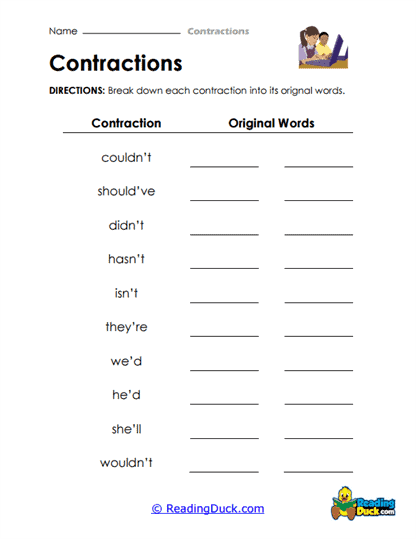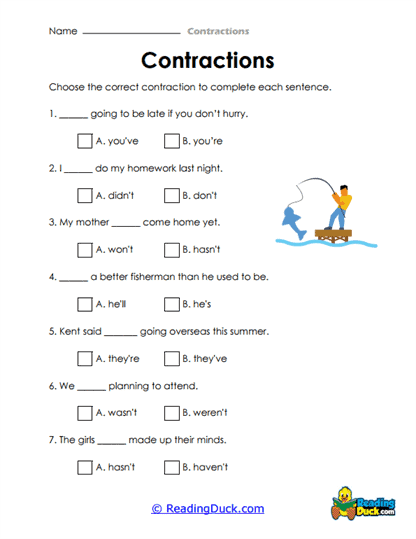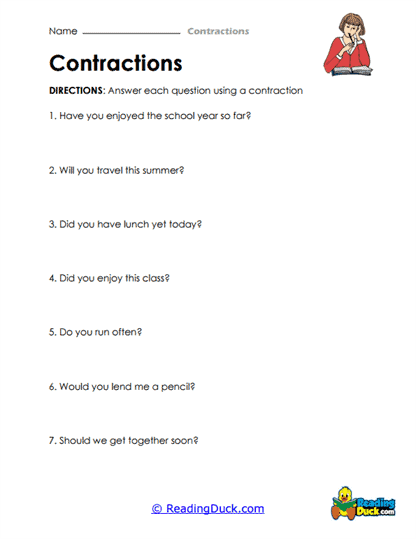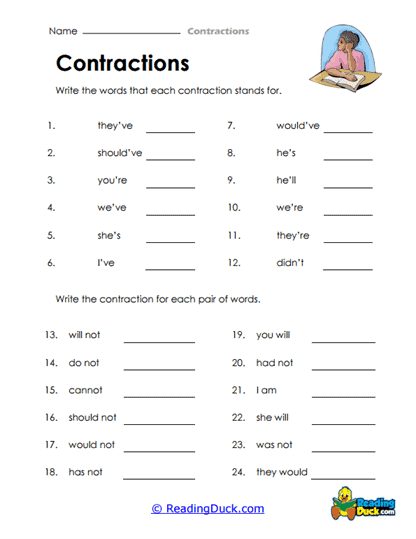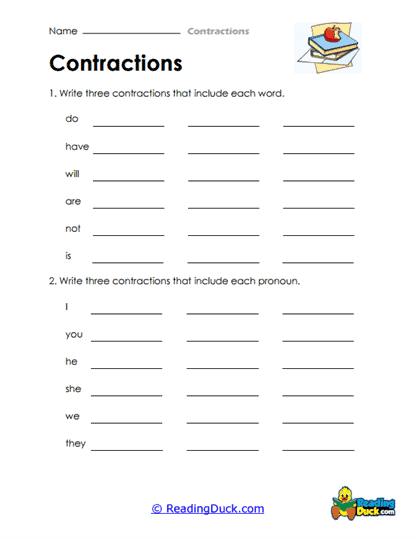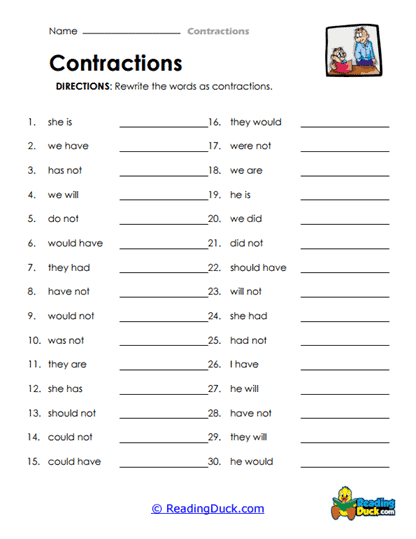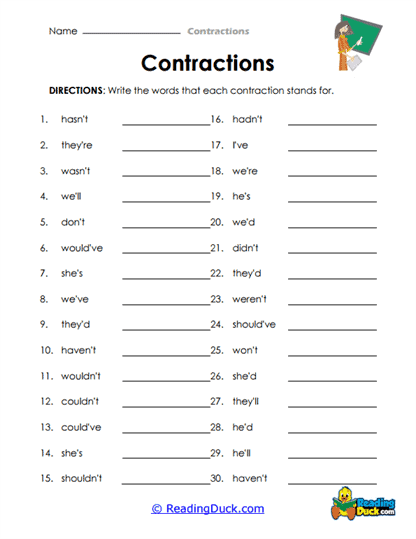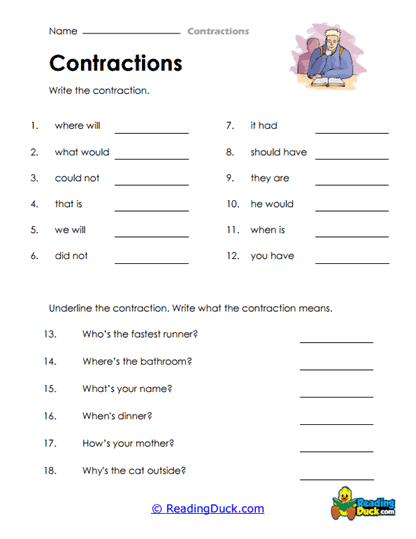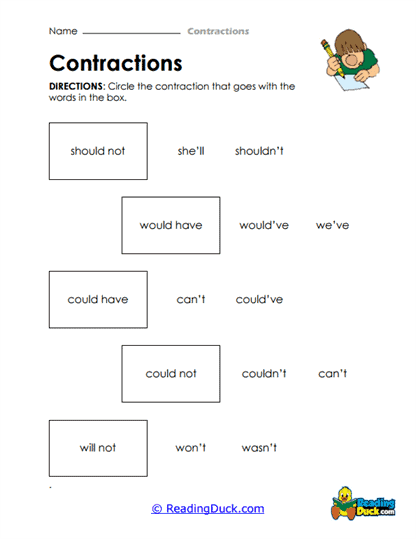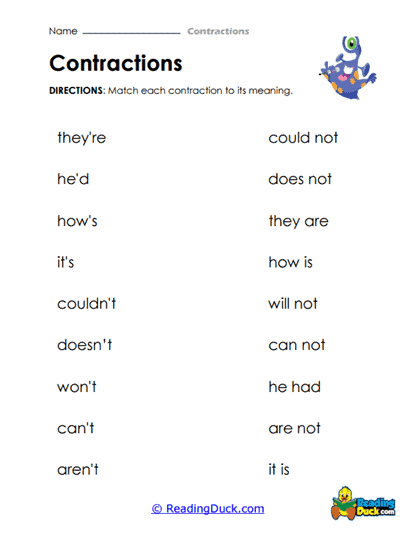Contractions Worksheets
About Our Contraction Worksheets
Our collection of Contractions Worksheets is designed to help students develop a strong understanding of this essential grammar skill. Falling under the Grammar category within the broader Skills section, these worksheets focus on teaching students how to form, recognize, and correctly use contractions in their writing and speech. Contractions are a common feature in both spoken and written English, making them an important area for mastery. These worksheets assist learners in understanding how two words are combined and shortened into a single word, helping them write more naturally and efficiently.
These worksheets cover a wide range of contractions, from basic forms like can’t and won’t to more advanced structures, ensuring students at different levels can progress at their own pace. The worksheets encourage students to practice both forming contractions and identifying them within sentences. By completing these activities, students can refine their ability to use contractions appropriately in various contexts. The worksheets are provided in PDF format, making them easy to view, download, and print for convenient use in both classroom and home settings. Additionally, each worksheet comes with a downloadable answer key to help assess student progress and offer guidance where needed.
Exploring Contractions: What They Are and How They Work
Contractions are an essential part of English grammar, frequently used in everyday conversation and informal writing. Understanding how contractions function allows students to communicate more effectively and naturally.
Definition of Contractions:
Contractions are formed by combining two words and omitting certain letters, replacing them with an apostrophe. The apostrophe marks the missing letters and helps to shorten the phrase. Contractions are commonly used to make language more concise and conversational. For example, instead of saying "do not," we say "don’t." This shorter form allows for smoother, more fluent speech and writing.
Types of Contractions:
Negative Contractions:
- These contractions are formed by combining a verb with the word not. They are among the most common contractions in English and include forms such as:
don’t (do not)
won’t (will not)
can’t (cannot)
isn’t (is not)
- Example: "She doesn’t like ice cream" is a more conversational form of "She does not like ice cream."
Pronoun + Verb Contractions:
- These contractions involve the combination of a pronoun and a verb, typically a form of "to be" or "will." Examples include:
I’m (I am)
You’re (You are)
They’ve (They have)
He’ll (He will)
- Example: "He’ll go to the store" is a contracted version of "He will go to the store."
Other Common Contractions:
- Some contractions don’t fall neatly into the categories above but are still widely used. Examples include:
let’s (let us)
who’s (who is or who has)
she’d (she had or she would)
- Example: "Let’s go to the park" is a contraction of "Let us go to the park."
Importance of Contractions:
Contractions play a key role in making language sound more fluid and less formal. In everyday communication, contractions help streamline speech and make interactions feel more natural. Although contractions are typically avoided in formal writing, they are prevalent in informal contexts, creative writing, dialogue, and personal communication. Mastering contractions helps students move away from stilted or overly formal language, improving their ability to write and speak in a way that reflects natural, conversational English.
Engaging Techniques for Teaching Contractions
Introducing contractions to students can be a fun and interactive process if done with the right techniques. Educators can use several methods to ensure students fully grasp the concept while keeping them engaged.
- Start with Familiar Examples: Begin by introducing contractions that students are likely already familiar with, such as can’t, won’t, and I’m. This helps students feel more comfortable with the concept before moving on to less common contractions.
- Example Exercise: Provide students with two-column charts where one side contains the full form of the words (e.g., "do not") and the other side shows the contraction (e.g., "don’t"). Have them match each word pair.
- Use Visual Aids: Create visual aids, such as posters or flashcards, that show the two words being contracted, along with the resulting contraction and the apostrophe placement. This helps reinforce the concept visually, showing students which letters are omitted.
- Interactive Games: Incorporate games like “Contraction Bingo” or “Contraction Match-Up,” where students are given cards with either the full forms or contractions and must find the corresponding pair. This encourages active participation while reinforcing their learning.
- Practice with Dialogues: Have students write short dialogues between two characters, encouraging the use of contractions to make the conversation sound more natural. This allows them to see how contractions are used in everyday communication.
Overcoming Common Challenges in Learning Contractions
Students may face certain difficulties when first learning about contractions, especially regarding apostrophe placement or distinguishing between similar-looking contractions.
- Challenge: Misplacing the Apostrophe: One of the most common issues is students misplacing the apostrophe or forgetting it entirely when writing contractions. This error can lead to misunderstandings or grammatically incorrect sentences.
- Strategy: Use hands-on activities, such as providing students with cut-out letters, where they can physically remove the omitted letters and replace them with an apostrophe. This tactile approach helps students internalize the process of forming contractions.
- Challenge: Confusing Similar Contractions: Contractions like its and it’s or there’s and theirs can easily confuse students, especially since these forms sound alike but serve different grammatical purposes.
- Strategy: Create exercises that focus on commonly confused contractions, asking students to choose the correct form in a given sentence. For example, provide two sentences—“It’s raining” and “The dog wagged its tail”—and have students determine which contraction fits each context.
- Challenge: Overusing Contractions in Formal Writing: While contractions are appropriate in informal contexts, students may overuse them in formal writing assignments, which could detract from the professionalism of their work.
- Strategy: Teach students to differentiate between formal and informal writing. Give examples of both styles and practice rewriting informal sentences without contractions for more formal contexts.
Creative Activities for Reinforcing Contractions
To help students fully grasp and retain the concept of contractions, educators can provide supplementary activities that make learning engaging and interactive. These activities work well in both traditional classroom settings and homeschool environments.
- Contraction Hunt (Grades 2-4): Have students search through a favorite book, magazine, or article for contractions. Ask them to list the contractions they find and write the full form next to each one. This helps reinforce how contractions are used in real-world texts.
- Contraction Creation Station (Grades 1-3): Set up a “Contraction Creation Station” where students can use magnetic letters or cut-out paper letters to form contractions from two separate words. This hands-on activity allows younger students to physically see how letters are omitted and replaced with an apostrophe.
- Contraction Story Time (Grades 3-5): Have students write short stories or paragraphs where they must include a set number of contractions. This creative exercise encourages them to apply what they’ve learned about contractions in a fun and imaginative way.
- Contractions Relay (Grades 2-4): Organize a relay race where students are given index cards with either full words or contractions. In teams, they must race to the board and match the full forms to their contracted counterparts. This game adds an element of competition, which can help motivate students to practice.
These activities are suitable for various grade levels, with early elementary students (grades 1-3) benefiting from foundational exercises, while older students (grades 3-5) can engage in more complex contraction-related tasks.
Why Learning Contractions Is Essential
Mastering contractions is an essential skill for students as it directly impacts their ability to write and speak naturally. In informal writing, emails, dialogues, and everyday speech, contractions make communication more fluid and efficient. Additionally, understanding contractions helps students read more fluently, as they will frequently encounter these shortened forms in books, magazines, and online content.
Being able to switch between using contractions in informal settings and avoiding them in formal writing tasks, like essays and reports, is a valuable skill that enhances a student's adaptability in different contexts. Through these Contractions Worksheets, students will not only improve their grammar but also become more confident in both their written and verbal communication, preparing them for real-world applications where effective communication is key.
